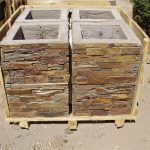Enhance Your Garages Appearance with Stone Veneer A Comprehensive Guide

Introduction:
Garages are often overlooked when it comes to home improvement projects, with most homeowners focusing on the interior and exterior of their main living spaces. However, the garage is an essential part of the home and can greatly benefit from aesthetic enhancements. One popular way to upgrade the appearance of a garage is by using stone veneer. Stone veneer is a versatile and cost-effective material that can transform the look of any garage, giving it a luxurious and sophisticated appearance. In this comprehensive guide, we will explore the benefits of using stone veneer on your garage, the different types of stone veneer available, installation methods, maintenance tips, and design ideas to inspire you.
Benefits of Stone Veneer for Garages:
1. Enhances Curb Appeal: One of the main benefits of using stone veneer on your garage is the instant boost in curb appeal. Stone veneer adds a touch of elegance and sophistication to your home's exterior, making it stand out in the neighborhood.
2. Durable and Long-Lasting: Stone veneer is a durable material that can withstand harsh weather conditions, UV rays, and temperature fluctuations. This makes it an ideal choice for garage exteriors, as it will maintain its appearance and structural integrity for many years.
3. Versatile Design Options: Stone veneer comes in a wide range of colors, textures, and styles, allowing you to customize the look of your garage to suit your personal taste and complement the rest of your home's exterior.
4. Cost-Effective: Compared to natural stone, stone veneer is more affordable and easier to install. It provides the same aesthetic appeal as natural stone but at a fraction of the cost, making it a budget-friendly option for homeowners looking to upgrade their garage's appearance.

Types of Stone Veneer for Garages:
1. Natural Stone Veneer: Natural stone veneer is made from real stone that has been cut into thin slices. It provides an authentic and organic look to your garage, with each piece showcasing unique variations in color and texture. Natural stone veneer is more expensive than manufactured stone veneer but offers a timeless and high-end appeal.
2. Manufactured Stone Veneer: Manufactured stone veneer, also known as faux stone, is made from a mixture of concrete and pigments that are molded and colored to resemble natural stone. It is a more affordable option than natural stone veneer and comes in a wide range of styles and colors to suit any design preference.
3. Brick Veneer: While not technically stone veneer, brick veneer is another popular option for garage exteriors. Brick veneer offers a classic and traditional look, adding charm and character to your garage. It is available in various colors and sizes to create a custom appearance for your garage.
Installation Methods for Stone Veneer:
1. Adhered Veneer Installation: Adhered veneer installation involves attaching the stone veneer directly to the garage's existing exterior surface using a mortar or adhesive. This method is suitable for both natural and manufactured stone veneer and provides a secure and durable bond.
2. Mortarless Veneer Installation: Mortarless veneer installation, also known as dry stacking, does not require mortar or adhesive to attach the stone veneer. Instead, the stones are stacked tightly together using interlocking mechanisms or clips. This method creates a seamless and modern look for your garage.
3. Panelized Veneer Installation: Panelized veneer installation involves using pre-fabricated stone panels that are attached to the garage's exterior surface. This method is quicker and easier than traditional stone veneer installation, as the panels come ready to install with minimal cutting or shaping required.
Maintenance Tips for Stone Veneer Garages:
1. Regular Cleaning: To keep your stone veneer garage looking its best, it is important to regularly clean the surface to remove dirt, dust, and debris. Use a mild detergent and water solution to gently scrub the stone veneer and rinse with clean water.
2. Sealing: Depending on the type of stone veneer used, it may be beneficial to apply a sealant to protect the surface from water damage, staining, and color fading. Consult with a professional to determine the appropriate sealant for your specific stone veneer.
3. Inspect for Damage: Periodically inspect your stone veneer garage for any signs of damage, such as cracks, chips, or loose stones. Repair any damage promptly to prevent further deterioration and maintain the integrity of the stone veneer.
Design Ideas for Stone Veneer Garages:
1. Rustic Elegance: Create a rustic and elegant look for your garage by using natural stone veneer in earthy tones like brown, gray, or tan. Pair the stone veneer with wooden accents, such as a matching garage door or trim, to enhance the rustic charm.
2. Modern Minimalism: For a sleek and contemporary design, opt for a manufactured stone veneer in a monochromatic color palette, such as black, white, or gray. Keep the design simple and clean with minimal detailing to achieve a modern minimalist aesthetic.
3. Mediterranean Inspired: Bring a touch of Mediterranean flair to your garage with warm-toned stone veneer in shades of terracotta, sand, or cream. Add decorative elements like wrought iron accents or arched windows to complete the Mediterranean-inspired look.
Conclusion:
Stone veneer is a versatile and stylish choice for enhancing the appearance of your garage. Whether veneer stone prefer the natural beauty of real stone veneer or the affordability of manufactured stone veneer, there are endless design possibilities to transform your garage into a stunning focal point of your home's exterior. By choosing the right type of stone veneer, following proper installation methods, and implementing regular maintenance practices, you can enjoy a beautiful and durable garage facade for years to come. Consider incorporating stone veneer into your next home improvement project to elevate the curb appeal and value of your property.
